 The
Figge Art Museum's Contemporary
Glass Invitational feels
dangerous. The glass process itself carries the physical peril of
fire and molten liquid. The artistic effects are also unsettling,
combining soothing beauty with surprise. These glass sculptures glow
with intense and subtle visual pleasures, but they also create
anxiety through their tensions and contradictions.
The
Figge Art Museum's Contemporary
Glass Invitational feels
dangerous. The glass process itself carries the physical peril of
fire and molten liquid. The artistic effects are also unsettling,
combining soothing beauty with surprise. These glass sculptures glow
with intense and subtle visual pleasures, but they also create
anxiety through their tensions and contradictions.
We are attracted by the resemblance to the familiar, yet we are also astonished by the free expressions of an art. We sense a great mastery of classical technique, but we are constantly startled by their innovative use of the glass material.
These works are fragile but sturdy, realistic but also abstract - hard to secure in our own understanding. Ancient forms, images, and emotions are expressed in a three-dimensional medium of our time.
This exhibition is the result of almost two years of work by guest curator and Rock Island glass artist Mark Fowler, who has brought into one display a selection of 22 emerging and established glass artists from around the country. It can be seen at the Figge Art Museum until May 11, with artist lectures and demonstrations scheduled for four Saturdays.
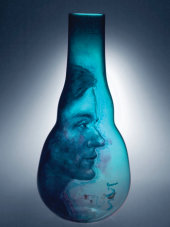 Glass
is created with the common materials of sand, soda, and lime fused
with intense heat and then formed. We think of early Egyptian and
Roman jars, medieval stained-glass windows, and Tiffany lamps. But
not until the past 50 years has glass been considered a medium to
make any "real" or "high" art.
Glass
is created with the common materials of sand, soda, and lime fused
with intense heat and then formed. We think of early Egyptian and
Roman jars, medieval stained-glass windows, and Tiffany lamps. But
not until the past 50 years has glass been considered a medium to
make any "real" or "high" art.
The first piece we come to is in the entrance gallery by the Figge's first-floor elevator. It's by Michael Meilahn, a corn farmer with a Master of Fine Arts, and his sole subject is corn. He presents Corn Zone, 28 large cast-glass corn cobs in six colors, bungee-corded from the ceiling in even rows. Each ear of corn is insecurely pierced by long multicolored glass rods with tufts of genetic material or psychedelic twists.
On the wall behind the display, three repeating projected videos show moving patterns of these hanging pieces and of the planting and harvesting of real corn, complete with thundering and pouring sounds. His is the perfect introduction for the rest of the exhibition: It's both engaging and distressing. We have an idealized view of agriculture on the walls contrasted with these suspended arhetypes of corn elevated to an icon, in the manner of Madonnas or dream landscapes.
When we first enter the gallery on the third floor, we are confronted with the four-foot-tall Shelter by Brent Kee Young. Suspended inside a large, latticed, bullet-shaped form is an open house, and inside the house is a delicate ladder standing from the floor to the ceiling. It's all created with thin Pyrex rods, flame-"welded" into a web of clear filigree. Like a maze of roots or nerves, the parts look organic and complex, combined with the strong geometry of reason. The rational is housed within the natural, and the logical within the biological.
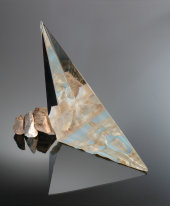 Nearby
stand three bottle-shaped statues by KéKé Cribbs. They
look like exuberant anime creatures whose heads should spin and make
whirring sounds. All are covered in a bright glass mosaic, with tiny
arms, big listening ears, red-rouged clown faces, and large teacup
hats. The whimsical two-foot-tall Mr.
Stubbs has a long blue
river flowing from his neck to his base and an equator of gold
surrounding the belly. His ceramic body is covered in hundreds of
handmade glass pieces. He is like the sweet and wise Nutcracker, the
strange jester from an imaginary cartoon come to life, or a totem
from another world. His face is humorous but also a bit frightening
with its intense stare. We don't know whether to smile or move away
quickly.
Nearby
stand three bottle-shaped statues by KéKé Cribbs. They
look like exuberant anime creatures whose heads should spin and make
whirring sounds. All are covered in a bright glass mosaic, with tiny
arms, big listening ears, red-rouged clown faces, and large teacup
hats. The whimsical two-foot-tall Mr.
Stubbs has a long blue
river flowing from his neck to his base and an equator of gold
surrounding the belly. His ceramic body is covered in hundreds of
handmade glass pieces. He is like the sweet and wise Nutcracker, the
strange jester from an imaginary cartoon come to life, or a totem
from another world. His face is humorous but also a bit frightening
with its intense stare. We don't know whether to smile or move away
quickly.
Across the gallery are five classically proportioned bowls and vessels by Sonja Blomdahl. On the surface, pale ochers, various blues, soft purples, a delicate pearl, and a sumptuous aqua glow from these quiet shapes. Her difficult technique, called "incalmo," fuses blown glass in sections to make the round forms; her seamless skill alone is worth the view. But despite their elegance there is a small disquiet. The bowls want to move, tilt, and take off. But they are bound to their spot, as if they have been recently unearthed from another time and polished up. They seem frightened to be sitting here.
Jackie Pancari has made two series of round glass containers. One group of three is filled with light-reflecting water and bright glass letters that are seen through the transparent windows of the opaque containers. The other series is of four progressively larger cylinders packed with increasing sizes of glass spheres (numbering 15, five, two, and one, with the biggest number in the smallest container). The largest round orb weighs 25 pounds. To make a perfect sphere in glass is difficult, and presenting them in these calm conceptual pieces hides the intense craftsmanship of her process. They appear effortless and scientific, exuding serene stillness. Her most intense feelings are poured into passionate craftsmanship.
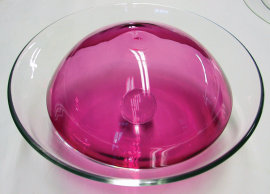 Three
feminine and futuristic glass flower arrangements by Robin Cass hang
on two walls of their own quiet arena. Elongated, hollow, and opaque
forms with long beaks, like the fleshy and weary figure in Dali's
The Persistence of Memory,
are crossed by opaque-green copper branches with clusters of glass
flowers and leafs, or the tendrils of long grasses. Like an Aubrey
Beardsley drawing, the moody combination of these two elements is
both appealing and peculiar. We are taken in by their loveliness, but
react to their almost decadent atmosphere. Herb Metzler's excellent
lighting casts these pieces in strong shadows on the wall, as if they
were spotlighted figures on a stage of enjoyable melancholy.
Three
feminine and futuristic glass flower arrangements by Robin Cass hang
on two walls of their own quiet arena. Elongated, hollow, and opaque
forms with long beaks, like the fleshy and weary figure in Dali's
The Persistence of Memory,
are crossed by opaque-green copper branches with clusters of glass
flowers and leafs, or the tendrils of long grasses. Like an Aubrey
Beardsley drawing, the moody combination of these two elements is
both appealing and peculiar. We are taken in by their loveliness, but
react to their almost decadent atmosphere. Herb Metzler's excellent
lighting casts these pieces in strong shadows on the wall, as if they
were spotlighted figures on a stage of enjoyable melancholy.
Not everything is unsettling in the show. In the back of the gallery hang three luminous tapestry images by Laura Willits. Her best is a sublime landscape of a river and trees, called Green Water Shadow, made of countless tiny glass beads.
She begins from digital photographs and works them up on a small bead loom, transforming her experience. The countless textured colors are intricately woven, bead by bead. Her glimmering mosaic combines the subtle atmosphere of evening with Seurat-like dots of brilliant memoried sparkles. We are dreaming in delicate radiant colors. There is no anxiety here, only reminiscence of an actual place, keenly touched.
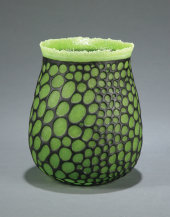 Nearby,
two groups of artists are not so much perilous as beguiling.
Mysterious, enticing faces and figures by Fred diFrenzi emerge from
behind several layers of glass. Each relief is carved into a slab of
plaster, cast with a rubber mold, polished, and then reverse-painted
with colors and gold leaf.
Nearby,
two groups of artists are not so much perilous as beguiling.
Mysterious, enticing faces and figures by Fred diFrenzi emerge from
behind several layers of glass. Each relief is carved into a slab of
plaster, cast with a rubber mold, polished, and then reverse-painted
with colors and gold leaf.
The red lips and red fingernails of Sir Francis Bacon Valhine set off the exotic face of a Byzantine Madonna within an oval, surrounded with blue flowers and a lovely purple-to-turquoise background. Her face seems current and ancient, mythical and personal. There is no danger here but for the character of the enticing woman. If you can peer around to the back of his pieces to see the process, do so, although move slowly and deliberately.
Another grouping of faces is a collaboration by two glass painters, Walter Lieberman and Dick Weiss (who go by WD40+). On vases formed by others, they create their images of somber expression, in tag team, with 10 to 15 firings in enamel paint. One artist works slowly, and the other fast. Over everything appear Dremel-tooled words of indecipherable content. We see both clarity and mystery in their work.
Across the hall are the purely beautiful wedges of transparent cast-glass landscapes by Kreg Kallenberger. Images of rivers and cliffs near his home studio in Tulsa, Oklahoma, are "painted" inside the large gleaming prisms, which are accompanied on the outside with smaller rocks or glass crystals. The invisible surface is highly polished with little edges of applied color. We can look through the transparent glass into these little scenes and see his brilliant technique capturing a natural landscape in a slice of light and time. We're peering into an uncommon little world, complete with weather, sand, foliage, and water. These are real but strongly fabricated illusions, charging their interior air with an invisible presence.
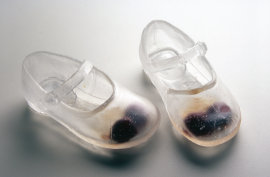 Near
the front of the gallery are four witty fantasies by Nancy Callan of
two large, perfectly formed toy glass tops - which could only be
spun by a giant child - and two long, plaid chocolate kisses. Their
tightly detailed forms obscure the incredible finesse of her Venetian
cane technique, of making numerous passes of controlled color in
multiple directions to create the soft plaid surface. The pieces lie
quietly, waiting for someone to play with them, but no one can.
They're made for another world.
Near
the front of the gallery are four witty fantasies by Nancy Callan of
two large, perfectly formed toy glass tops - which could only be
spun by a giant child - and two long, plaid chocolate kisses. Their
tightly detailed forms obscure the incredible finesse of her Venetian
cane technique, of making numerous passes of controlled color in
multiple directions to create the soft plaid surface. The pieces lie
quietly, waiting for someone to play with them, but no one can.
They're made for another world.
Dante Marioni is the show's traditional glass blower, with flowing forms, strongly contrasting colors, long, delicate necks, and small, subtle bases. His work is classical but eccentric. His tall objects look like vases and cups on steroids - huge, elongated, and powerful. We feel admiration for his skill, but surprise at the juxtaposition of grace with subtle exaggeration. This is the work of an artist who has thoroughly mastered his art and now easily plays with the forms.
There are numerous other pieces worthy of our full attention and delight. This is a satisfying show, filled with stunning objects that spur multiple and often contradictory emotions.
But beware: It is not an exhibit for large purses, puffy coats, or unaccompanied children.
Clear Your Mind: Contemporary Glass Invitational runs through May 11. Artist talks and demonstrations are scheduled for February 23, March 29, April 12, and May 3 at the Figge and at Mark Fowler's Liquid Fire studio, underneath the Arsenal Bridge in Rock Island. For more information, visit (http://www.figgeartmuseum.org).










